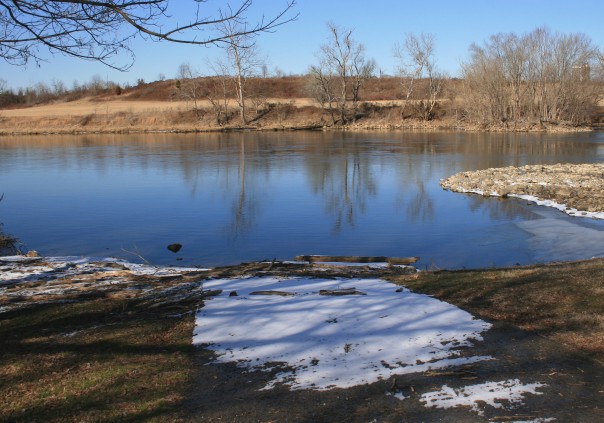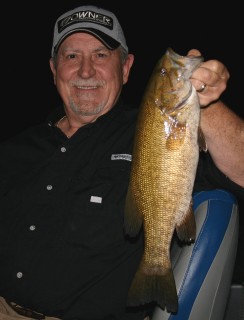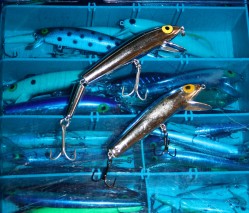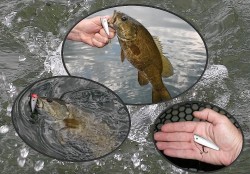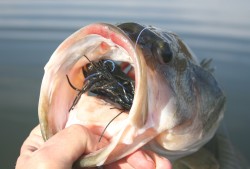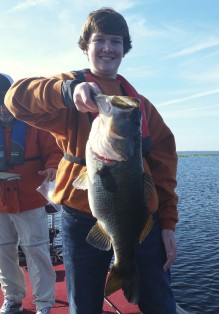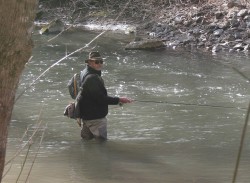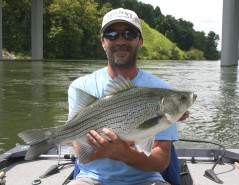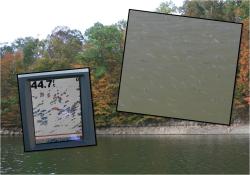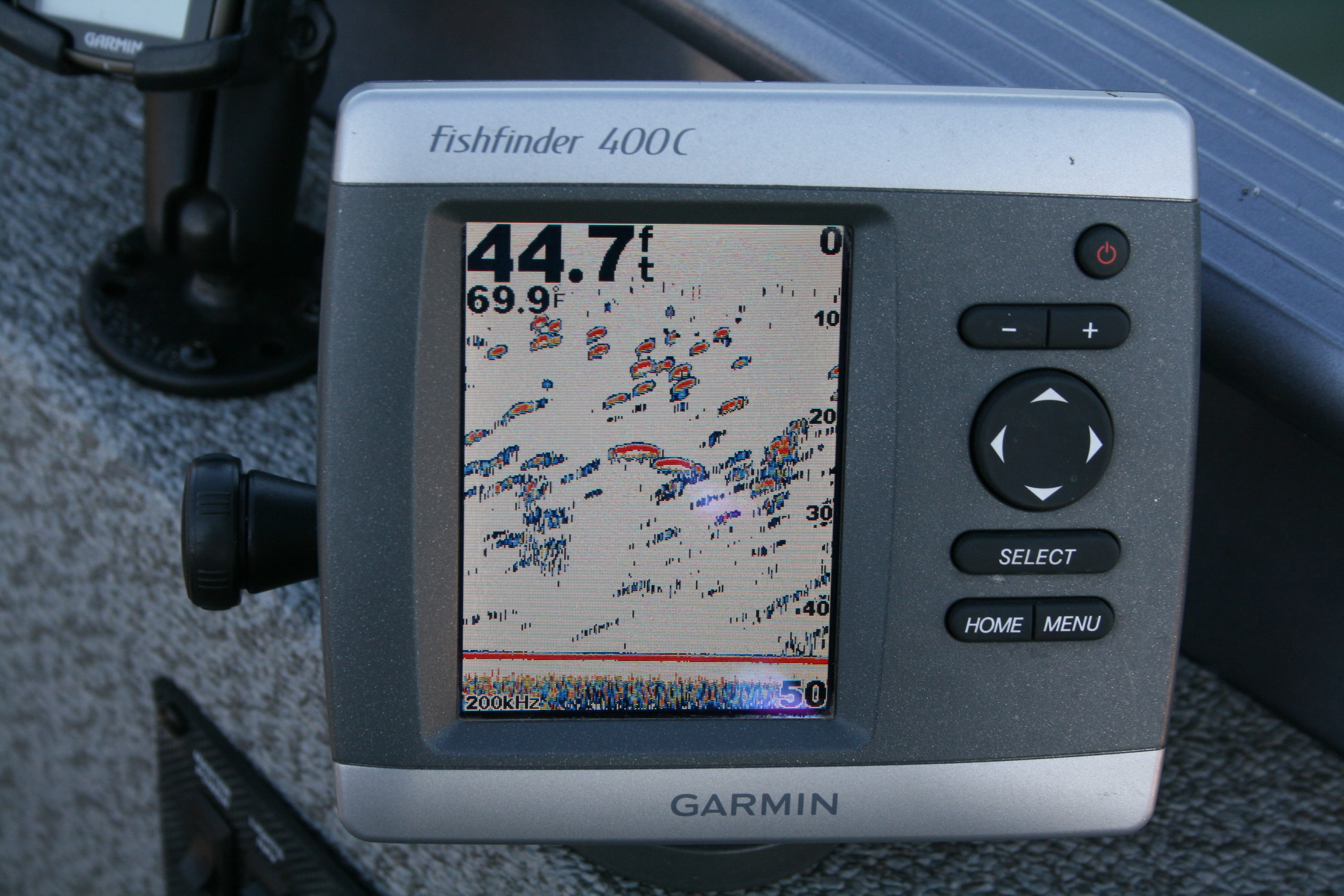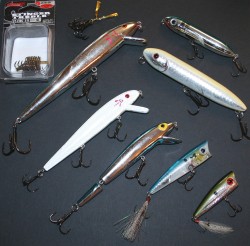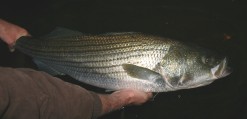Blog Archives
Good-bye Winter, Hello Spring!
I didn’t think spring would ever get here. I enjoy good fishing year round but must admit that opportunities during the cold-water period can be limited, especially so when temperatures run below average, snowfall is much more frequent and winter storms continually pass through like an invading army. Global warming? Global freezing seemed a more accurate description this year. Despite the weather, I’ve kept busy enjoying some good late-winter, early-spring fishing since the Holidays with a few book-signings sprinkled in. Weather during the East Tennessee Fishing Show in Knoxville in mid-January was surprisingly good. The show was packed all four days and I met many new angling friends who were eager for the spring fishing season to arrive; not so at the West Virginia Outdoor Sports Show in Morgantown the first weekend in March. Show officials there called me the second morning of the two-day event and advised me to “Run…go South, quickly, before the approaching storm arrives.” A quick check of local radar confirmed they weren’t just trying to get rid of me. Winter Storm Titan spanked me down the Interstate with sleet and ice for most of an hour before I managed to escape, minus some of the equipment I hastily abandoned. It was a white-knuckled driving experience to start but I found sunshine and 60-degree temperatures when I arrived at home. Unfortunately, that didn’t last long. I don’t remember seeing free-flowing rivers in northeast Tennessee freeze during winter as they did this year.
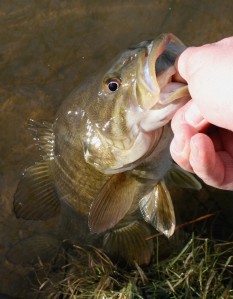 On better weather days, I found productive fishing for smallmouth bass and trout this winter by monitoring the forecast, water temperatures and conditions. In the last few weeks the weather has improved, temperatures have climbed and many spring spawners have started moving into the shallows. Trout provide exceptional fishing when the spring warm-up begins but one of my favorite early spring trips is for prespawn smallmouth bass in rivers. When smallies begin moving shallow in spring they become aggressive in the warming water. As temperatures rise, they begin moving to and cruising potential spawning areas where they soon develop an attitude. A combination of increasing metabolism and the drive to defend spawning sites makes them aggressive and susceptible to fast-moving presentations. Then it’s time to set aside slow-moving plastics that are so effective in cold water and pick up some hard baits. Steadily retrieved crankbaits in crawfish and baitfish colors are good choices for finding and catching fish. But my go-to choice in lures for prespawn smallmouth bass is shallow-running minnow lures. Minnows in the three- to four-inch range presented with fast, erratic retrieves eliminate water quickly and attract savage strikes from shallow-cruising river smallmouths. Minnow lures in natural baitfish colors work best in clear water under sunnier skies; brighter, flashier colors work best in stained water or under overcast skies. But these are not strict rules; test lure size and color until smallmouths confirm you’ve made the right choice and remain willing to change if light penetration or water clarity changes. A fast stop-and-go, darting retrieve mixed with short bursts of straight-line speed will draw many strikes after you find areas that hold fish. Find the right combination of size and color and it’s not unusual for smallmouths to be deeply hooked so bring along needle-nose pliers and handle the fish carefully to support healthy release.
On better weather days, I found productive fishing for smallmouth bass and trout this winter by monitoring the forecast, water temperatures and conditions. In the last few weeks the weather has improved, temperatures have climbed and many spring spawners have started moving into the shallows. Trout provide exceptional fishing when the spring warm-up begins but one of my favorite early spring trips is for prespawn smallmouth bass in rivers. When smallies begin moving shallow in spring they become aggressive in the warming water. As temperatures rise, they begin moving to and cruising potential spawning areas where they soon develop an attitude. A combination of increasing metabolism and the drive to defend spawning sites makes them aggressive and susceptible to fast-moving presentations. Then it’s time to set aside slow-moving plastics that are so effective in cold water and pick up some hard baits. Steadily retrieved crankbaits in crawfish and baitfish colors are good choices for finding and catching fish. But my go-to choice in lures for prespawn smallmouth bass is shallow-running minnow lures. Minnows in the three- to four-inch range presented with fast, erratic retrieves eliminate water quickly and attract savage strikes from shallow-cruising river smallmouths. Minnow lures in natural baitfish colors work best in clear water under sunnier skies; brighter, flashier colors work best in stained water or under overcast skies. But these are not strict rules; test lure size and color until smallmouths confirm you’ve made the right choice and remain willing to change if light penetration or water clarity changes. A fast stop-and-go, darting retrieve mixed with short bursts of straight-line speed will draw many strikes after you find areas that hold fish. Find the right combination of size and color and it’s not unusual for smallmouths to be deeply hooked so bring along needle-nose pliers and handle the fish carefully to support healthy release.
When rivers rise, stain and become unfishable for smallmouths, you can find plenty of good spring fishing by changing locations and species. Clear water in tail-waters below dams often produces good fishing for trout, walleyes, striped bass and others, including some exceptional trophies. However, reservoirs offer a variety of excellent spring fishing if you avoid the heavy bass-angling crowd during daylight hours. Many 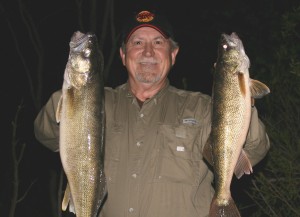 reservoirs across the south contain alewives as a primary food source and they spawn much earlier than shad, at night, and attract a variety of game fish into the shallows in early spring. So when the alewives come up, night fishing becomes a top choice for finding large predators in shallow water. The best shallow-water walleye action of the year begins on many southern reservoirs when alewives begin spawning along rocky shorelines at night and fishing pressure on walleyes is often light. Shallow- and deep-diving minnow or shad-shaped lures, swimbaits, spinners, spoons and jigs will all take fish. Walleyes can be finicky about lure choice, color and presentation but figure out what they want and the rewards can be impressive. Walleyes rank among the best in fresh water as table fare and their average size in better southern waters would shock many northern anglers. Learn much more about finding and catching spring walleyes in southern reservoirs and rivers in my book, The Weekend Angler’s Guide To Good Fishing.
reservoirs across the south contain alewives as a primary food source and they spawn much earlier than shad, at night, and attract a variety of game fish into the shallows in early spring. So when the alewives come up, night fishing becomes a top choice for finding large predators in shallow water. The best shallow-water walleye action of the year begins on many southern reservoirs when alewives begin spawning along rocky shorelines at night and fishing pressure on walleyes is often light. Shallow- and deep-diving minnow or shad-shaped lures, swimbaits, spinners, spoons and jigs will all take fish. Walleyes can be finicky about lure choice, color and presentation but figure out what they want and the rewards can be impressive. Walleyes rank among the best in fresh water as table fare and their average size in better southern waters would shock many northern anglers. Learn much more about finding and catching spring walleyes in southern reservoirs and rivers in my book, The Weekend Angler’s Guide To Good Fishing.
My most exciting adventure of the spring season so far was my first night-fishing trip to a local reservoir to check on hybrids. I’d found plenty of alewives splashing along shore one night on another lake while walleye fishing and assumed they’d be up at my favorite hybrid fishing spot. So I spooled fresh line on several rod-and-reel combos, packed my hybrid toolbox, and my favorite fishing buddy, and headed for hybrid heaven one evening as the sun set. Though I was well prepared, I had not tied on lures because I wanted to check water clarity and condition before deciding which to try first. Soon after we eased onto a place I was confident should hold hybrids, the water around us began exploding 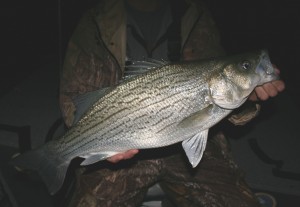 with feeding fish. I had just started loading an A-Rig with soft plastics but quickly decided that was going to take too long so I grabbed a spinning combo and in seconds had a large popping lure tied on. In the next hour, I lost count of the number of surface strikes we had. The frustrating part was that most were hits and misses though we caught and released several nice fish. I tried a variety of topwater lures in an attempt to increase my strike-to-catch ratio but saw little improvement. It seemed the hybrids would boil on most surface lures but were very selective about what they were willing to eat. I once tied on a seven-inch Cordell Red Fin to see if the fish preferred a larger-profile surface lure and caught a nice hybrid the first cast. But follow-up casts produced only boils. We were limited on time this trip and regrettably had to leave that impressive concentration of feeding fish. Trips like that will make you stare wide-eyed into the darkness when trying to sleep.
with feeding fish. I had just started loading an A-Rig with soft plastics but quickly decided that was going to take too long so I grabbed a spinning combo and in seconds had a large popping lure tied on. In the next hour, I lost count of the number of surface strikes we had. The frustrating part was that most were hits and misses though we caught and released several nice fish. I tried a variety of topwater lures in an attempt to increase my strike-to-catch ratio but saw little improvement. It seemed the hybrids would boil on most surface lures but were very selective about what they were willing to eat. I once tied on a seven-inch Cordell Red Fin to see if the fish preferred a larger-profile surface lure and caught a nice hybrid the first cast. But follow-up casts produced only boils. We were limited on time this trip and regrettably had to leave that impressive concentration of feeding fish. Trips like that will make you stare wide-eyed into the darkness when trying to sleep.
A week later, my friend and I loaded our gear and headed back for a rematch with the hybrids. This trip I packed a bag of ice with a goal of catching our limit of four nice hybrids for the table. Weather patterns had been warm and stable but other conditions at our honey-hole had changed dramatically. Because the lake was still filling, with an undesirable wind direction, our target fishing area was now covered with floating leaves, sticks and other debris so our hopes for another round of incredible topwater fishing were crushed. And for some reason, warmer weather no doubt a factor, there were boats everywhere including several pleasure boaters who were there to practice doing doughnuts. To say we were disappointed is an understatement as we sat in what was previously hybrid heaven, bobbing like a cork in an avalanche of boat wakes. Though again limited on time, we were determined to stick it out to see if conditions improved and the hybrids 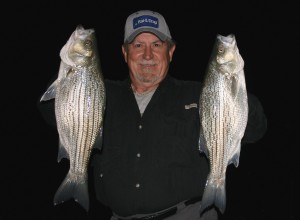 showed. After an hour or so of casting subsurface lures, primarily Rat-L-Traps and A-rigs, we accepted the fact the hybrids weren’t yet there. And even more disturbing, there were very few alewives present to attract predators. We had agreed on a latest stopping time and were approaching the last hour when suddenly, it became windy and the other boats began leaving. Soon, the wind had blown all the surface debris by us and out into the main lake. Then, as if by divine intervention, the wind calmed and alewives began bubbling along the now clean, calm surface. Minutes later we heard the first hybrid boil and the excitement began. With less than five minutes of fishing time left, I netted our fourth fish, a beautiful five-pound hybrid. After a few quick pictures and high-fives, we headed for the ramp right on schedule.
showed. After an hour or so of casting subsurface lures, primarily Rat-L-Traps and A-rigs, we accepted the fact the hybrids weren’t yet there. And even more disturbing, there were very few alewives present to attract predators. We had agreed on a latest stopping time and were approaching the last hour when suddenly, it became windy and the other boats began leaving. Soon, the wind had blown all the surface debris by us and out into the main lake. Then, as if by divine intervention, the wind calmed and alewives began bubbling along the now clean, calm surface. Minutes later we heard the first hybrid boil and the excitement began. With less than five minutes of fishing time left, I netted our fourth fish, a beautiful five-pound hybrid. After a few quick pictures and high-fives, we headed for the ramp right on schedule.
I’m looking forward to more exciting night-fishing for hybrids and walleyes in coming weeks because there’s plenty of good spring action ahead. Trout fishing will continue to improve in streams, rivers and tail-waters for numbers as well as trophy fish so I’ll be sure to include them on my schedule. Soon, bluegills will start making beds in warm, sun-baked areas and another of my favorite spring adventures will begin. It’s a wonderful time of year for recreational anglers to get out and enjoy good fishing because there are so many fish, and species, accessible in shallow water. It’s a great time to stock up on fresh fillets, catch that trophy of your dreams or introduce friends and family members to our favorite sport. If you’ve been saving back vacation time, it’s time to burn some because good spring fishing is now underway. And if you’re a die-hard reservoir bass angler, there’s no 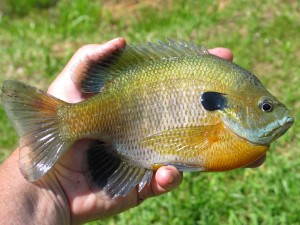 better time to get out and catch your share. Plan your time on the water under favorable weather, around major moon phases and where pressure is lowest and you too can enjoy some memorable spring fishing adventures. If you need help getting started, click on the picture of my book to order a paperback or kindle version or click the “Buy Books Locally” tab at the top of the page to find a place close by where you can pick up a copy. I hope to meet some of you on the water somewhere soon. Best of Luck!
better time to get out and catch your share. Plan your time on the water under favorable weather, around major moon phases and where pressure is lowest and you too can enjoy some memorable spring fishing adventures. If you need help getting started, click on the picture of my book to order a paperback or kindle version or click the “Buy Books Locally” tab at the top of the page to find a place close by where you can pick up a copy. I hope to meet some of you on the water somewhere soon. Best of Luck!
